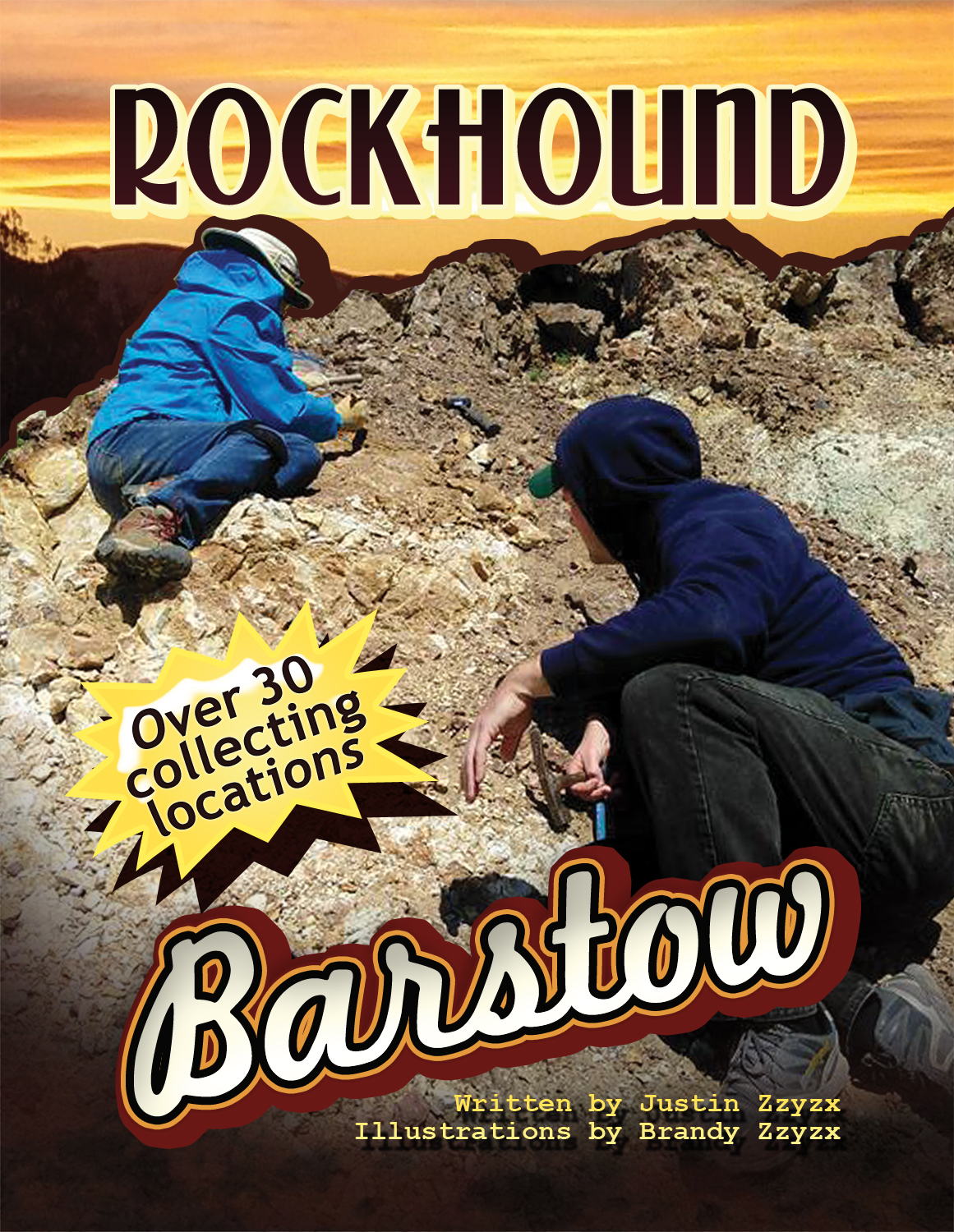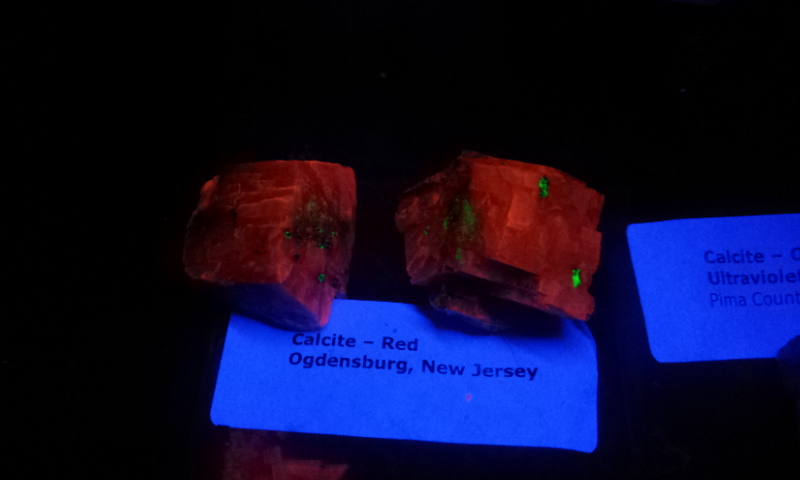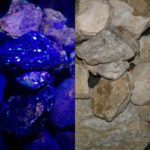
I enjoy seeing rocks light up under Short Wave Ultra Violet light, so do millions of other people in the world. It is exciting to see brilliant colors coming from, what commonly is, a not very visually stunning rock. While large exotic crystals can fluoresce, many times it is something drab and visually unappealing that shows brilliant reaction to “black light”. As the field trip leader for an active group of rock hounds, my monthly trip for February of 2017 was to the area known for brightly fluorescent rocks in the Shadow Mountains, just West of highway 395, in the high desert of Southern California.
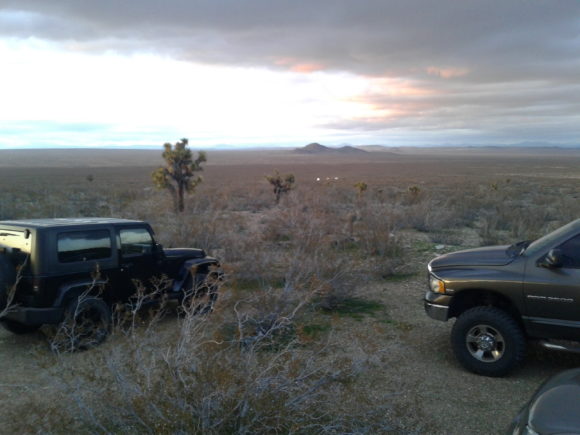
Every month we lead a field trip for the Mining Supplies and Rock Shop in Hesperia California, visit the shop and join us!

This photo shows the typical rocks found at the Shadow Mountain Tungsten District under normal light and under SW UV light.
To start out my planning for this trip, I did a basic Google search for what I thought the name of the mine was, the “Princess Pat Mine”. Google brought up some pages with various bits of information, some photographs, but no real indication of where the mine was specifically located. I then turned my attention to MRDS, as talked about in Rockhounding 101, this site can give me a list of mines, pinpointed on a map, showing what has been found in the area. It was a surprise to see that while there were a dozen or more deposits for Scheelite, the highly UV reactive mineral we were after, none of the mines were called “Princess Pat”. However, looking at the Google map, I noticed the road that takes you right to the majority of the scheelite deposits was called “Princess Pat Mine Road”. In fact, you simply turn west off the 395 onto this unmarked road and go for 5 miles until you hit the collecting area. But, why was I having such a pain finding the “Princess Pat Mine”?
I broke open Pemberton’s “Minerals of California” to find an entry for the Shadow Mountain Tungsten deposits on page 337, where it states “6. In the Shadow Mountains, on the northwest flank of Silver Peak, there are a number of scheelite deposits consolidated as the Just Associates quarries. The scheelite occurs in quartz veins cutting garnet-epidote-quartz tactite.” – however, no mention of the “Princess Pat Mine” – So, could it have been that the name “Princess Pat” was older or newer than this 1983 tome of California minerals? With this, I pulled out the Murdoch and Webb version of “Minerals of California”, 1966 edition, which leaves out the Shadow Mountain tungsten mines from the entries on scheelite in San Bernardino County.
Luck would serve me up a reference to “California journal of mines and geology”, Volume 49, which featured a fantastically in depth article on ore bodies of San Bernardino County, which reads
Just Tungsten Quarries (Just Associates, Princess Pat, Shadow Mountains Mines). Location: sees. 30 and 31, T. 8 N., R. 6 W., S.B.M., on
the northwest flank of Silver Peak, Shadow Mountains, about 13 airline miles west of Helendale and 14 airline miles northwest of Adelanto.
Ownership : Just Associates, E. Richard Just and Oliver P. Adams, 726
Story Building, Los Angeles, California, own unpatented claims totaling 440 acres. The property is leased to Just Tungsten Quarries, E.
Richard Just and associates, 726 Story Building, Los Angeles, California.The deposit, now known as the Just Tungsten Quarries, was discovered in 1937. Operations from late 1937 to early 1938 by the Shadow
Mountains Tungsten Mines and W. A. Trout and C. A. Rasmussen re-
sulted in the recovery of about 750 units of W0 3 from nearly 3000 tons
of selected ore treated in a 40-ton mill on the property. The operation
was not successful and the mill was dismantled. During the mid-1940 ‘s
lessees mined about 400 tons of ore, and during the late 1940 ‘s the
Princess Pat Mining Company leased the property but apparently produced no ore. Operations from April 1952 to mid-1952 have yielded a
few hundred tons of ore of undisclosed grade.The scheelite occurs in quartz veins cutting garnet-epidote-quartz
tactite bodies which exist at the contact between a Mesozoic granitic
rock and Paleozoic ( ?) metamorphic rocks, mostly impure limestone and
schist. The foliated rocks strike slightly north of east and dip gently
south. Scheelite-bearing tactite also has been developed, away from the
contact, along beds in the limestone, to form thin bodies of ore separated by barren limestone beds.The deposit was explored during 1937-38 by 1800 feet of zig-zag
trenches, 10 feet wide and 6 to 10 feet deep, excavated by a power shovel
up a moderate slope in a southwesterly direction. A 65-foot vertical shaft
was sunk near the lower end of this trench system, but no mining was
done underground.Employed in the early prospecting was a large field-type lamp requiring a 110-volt current, and a portable gasoline-powered motor generator set. This may have been the first practical application of a lamp
of this type.Ore is being mined from a bench cutting into a trenched area about
50 feet north of the shaft. Mining operations are carried on at night,
and the ore is sorted with the aid of ultra-violet light. Shipments have
been made to both the Jaylite and Parker custom mills in Barstow.
There you go, the “Princess Pat Mine” has the distinction of being a mine that produced no ore.
As it was, the tungsten mines produced little more than some naming confusions and quite possibly some bad debt, as the scheelite riches would never quite materialize from this deposit. Tungsten is an element that was listed by the United States Government as a strategic reserve, as most of our Tungsten comes from China, during WWII it was known that it would be scarce, so efforts were made to ensure production could be met at home. Plenty of trenches and tunnels were driven in this 140 acre unpatented claim, in the end, producing nothing more than a playground for collectors with an UV light.
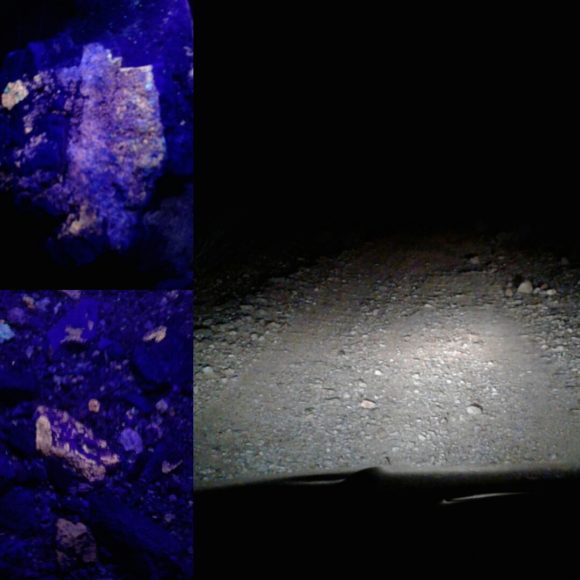
The mostly smooth desert road is littered with rocks that glow under SW UV light
There is often a little confusion as to what kind of Ultra-violet light one needs to get the enjoyment out of collecting UV minerals. I have used many varieties of products and I’ve found what I like and what I do not like. Obviously, a light with ample power is what one wants. Small hand held units are commonly available in 6 watt and under, which gives you a reaction when you hold the light VERY close to the specimen. However, the difference between a low wattage light and something in the 9, 18, or even, 36 watts will astonish every viewer. If you want maximum enjoyment out of UV collecting, a dual wave 18 watt light is a sound investment. Some minerals glow under Long Wave (365nm) range, but honestly, I find Long Wave to be the most limited, while Short Wave (285nm), produces amazing effects. When it comes to companies, well, some come and some go, while some are longstanding companies that I do not personally enjoy, when it comes to price vs. what you get, so, I would like to steer you in the right direction. At this time, in winter of 2017, there are no good companies to purchase a UV light from on Amazon.com. In fact, I would push you in two directions. #1, UVTools.com – They have been producing some fine lights, which come accompanied by a great informative kit. I highly recommend all the units they sell, even the sub-9 watt lights. #2, on eBay, the seller topazminer_minerals_and_fossils has been having great deals on a fine selection of high powered lights, at very reasonable prices. I would suggest viewing their offerings when looking for a great UV light.
If you like this article, check out the 28 page full color field guide “Rockhound Barstow” for sale online at the following links, now including the Princess Pat Mine Area, indepth!
Buy it on eBay
Order it on Amazon, or Buy it for Kindle eBook Readers
As part of the field trip series that I lead for the Mining Supplies and Rock Shop in Hesperia California, we took a trip out to the “Princess Pat Mine” area, or, as it should be known, the Just Associates Tungsten area, or, even still, the Shadow Mountain Tungsten area. You simply follow Princess Pat Mine road from highway 395 for 5 miles and you will find yourself facing the various prospect pits and trenches filled with cobbles and boulders of mostly white rocks that will glow readily under short wave light. You will see bright orange from the potassium rich calcite caliche, you’ll see bright green from the uranium included quartz. The bright white/blue scheelite is the real winner, appearing as belts of star-like dots in the rocky background. Rarely, one can find bright red from the wollastonite found in the area.

We have lead field trips for various groups and organizations
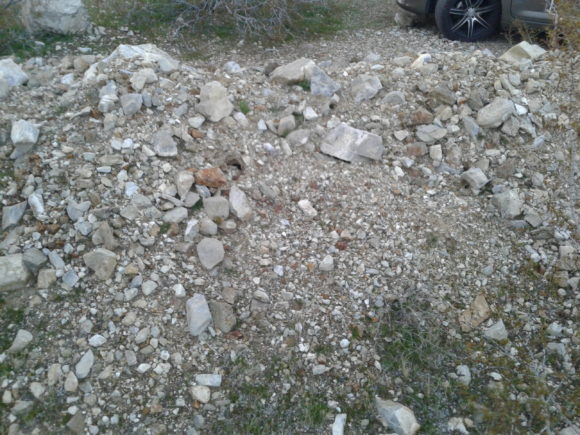
This pile of ore rubble was waiting for us at the parking area 1/10th of a mile from the start of the major trenching. This pile of rocks glows brightly if you do not wish to go into the rocky tailings beyond.
A group of about 30 of us descended on the mine area around 5pm, getting a view of the area before the sun set, by 6pm we were ready to see some rocks glow! Many of us came equipped with various powered UV lights. Some of the inexpensive LED Longwave lights were causing the calcite to glow a slight pinkish, but that was all, while the Shortwave lights were causing the whole area to light up. Everything around the area was glowing light wild, which lead to lots of happy rockhounds and many people remarking that they could not wait to come back and bring friends to show this wonderful area to. In this lonely desert, with no lights besides the moon and the stars, one can get some amazing results with a short wave ultra-violet light!
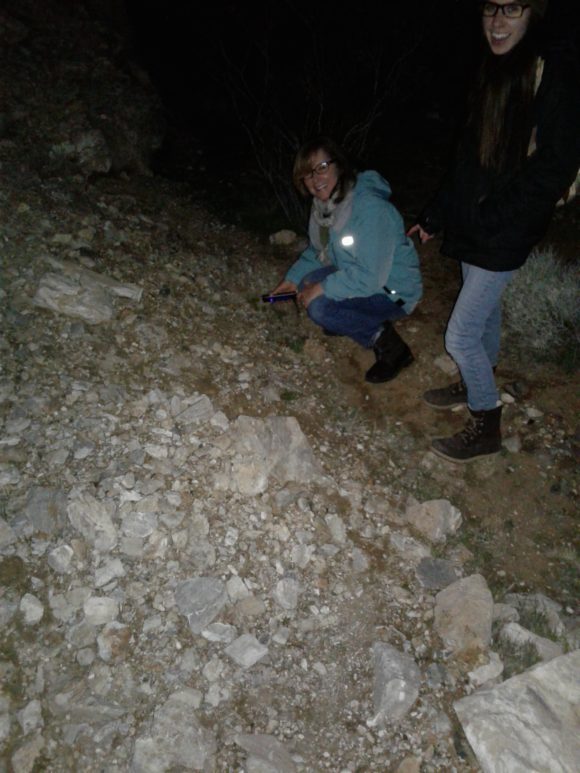
There were plenty of trenches pushed into the mountain which make great areas to illuminate the walls in search of black light rocks
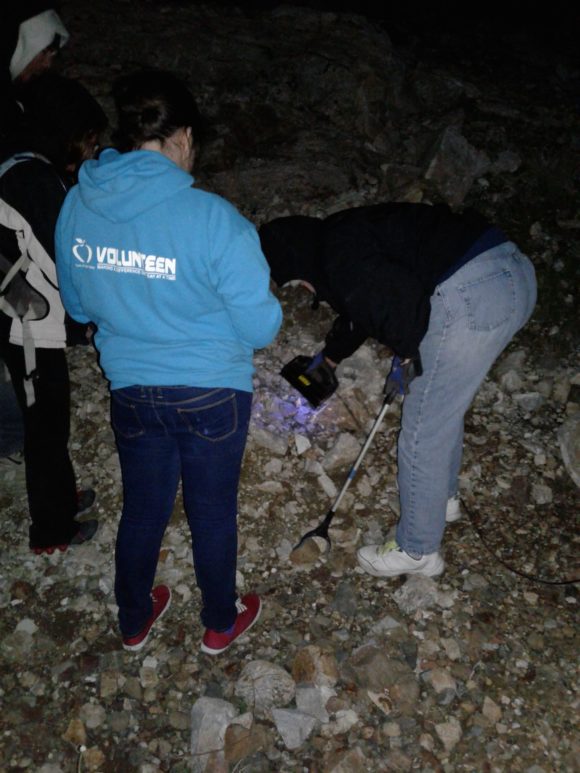
In the dark, scanning for rocks that react to SW Ultra Violet Light is a blast!
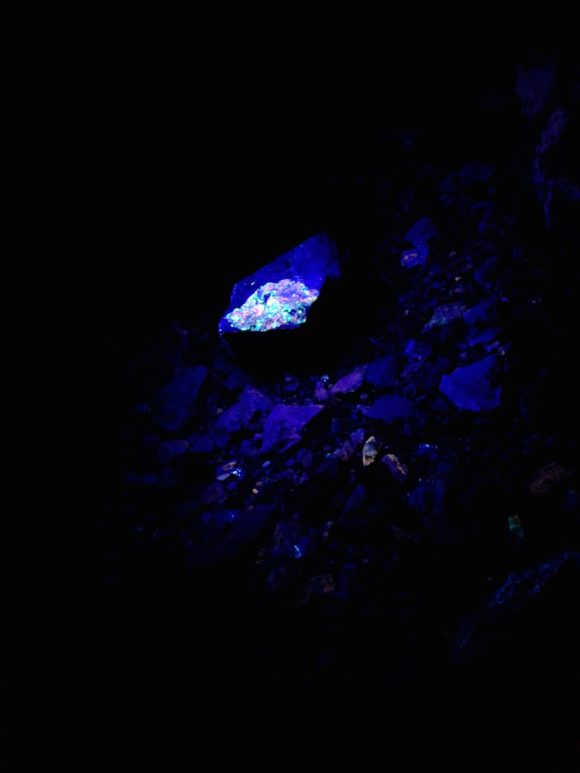
Here is a rock responding to SW UV light on the mine dump at the Princess Pat Mine/Just Associates Mine
So, go out and enjoy a day or night at the Shadow Mountain Tungsten District. There are no active claims, there is no ore of worth, it is just you and the coyotes, howling at the moon and looking down at the twinkling scheelite stars…
Related posts:
UV Light usage in mineral collecting – A Review of a dual band light under $100!
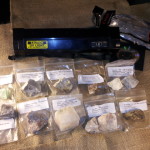
I finally got tired of not having a UV light to use in the field. Years ago I had a nice unit with dual LW/SW and a 12v cigar lighter plug, which worked with lots of portable battery packs and in my car for those nighttime visits to classic UV locations. Sadly, this light was lost and replacing it would be a few hundred dollars.
But, you never know how much you miss something like a good UV light until it is gone. There are just so many things a UV light helps with when checking out minerals. From the visual identification to seeing if a purchased specimen is glued, a good UV light pays for itself, quickly.
I was excited to read about the improvements to UVTools.com handheld Lamp, an all in one unit with a long wave bulb and a strong short wave bulb powered by 6 watts, a decent output, for just under $100. The kit comes with the light, which requires 3D batteries, a sample of minerals to test the light with shortwave and longwave reactive specimens. Safety goggles and a cd rom with study guides and informative literature complete the package, all in all, it gives a great start to any beginner, while the advanced collector will appreciate the power this highly portable hand held unit produces. I found the LW light to be very bright and it made some of the fluorites in my collection to glow bright white/blue. The shortwave light gives a bright reaction, but typically from a distance of no more than 6 inches from the lamp. It will not light up a hillside, or even a whole flat of minerals, but it is perfect for “one on one” specimen viewing.
Below: Photos of the kit, the minerals that came with it and some UV reaction from those specimens.
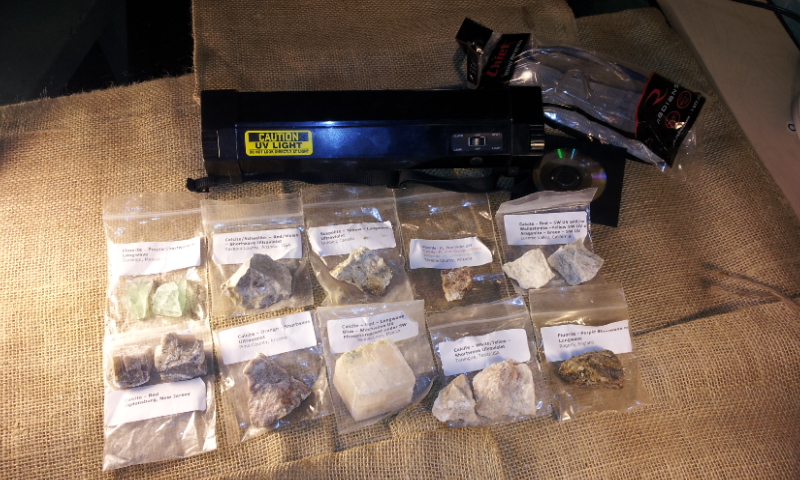
UV Kit, includes the lamp, 10 mineral specimens, safety glasses and a cd full of information. Available from http://UVTools.com
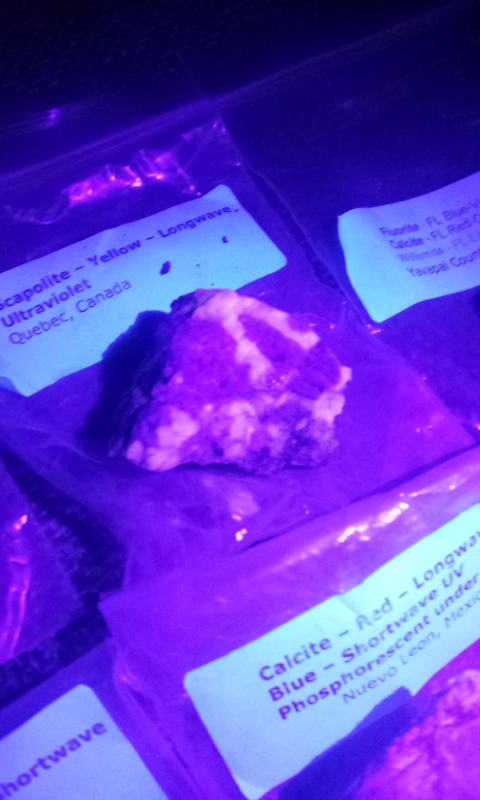
Longwave Light Sample (photo taken with Galaxy S2 Phone)
You can purchase this UV Lamp from the manufacture, directly at http://www.ultraviolet-tools.com for $99.99.
There were two interesting things I learned by using this UV light. This agate deposit near my house became that much more interesting when I found out that every single piece of agate glows bright green under shortwave light. That means there is a lot of uranium in the area, which is giving the agate that color. Then, a hill over from that agate deposit, at another agate deposit, the brown crust on some of the agates was determined to be an uncommon variety of feldspar, after it was found that these crystals, in micron size, were glowing bright pink, typical of the species. You might wonder, so what, crusts of brown on agate? Well, the sweet thing is that these agates would now glow three different colors, green, pink and orange, sometimes yellow, as well. Three color rocks are what it is all about, so being able to notice the brown crusty bits on some of the agates helps identify them for further UV evaluation! It should be no surprise, those glowing agates include the local petrified palm root and what I like to call “Manix Lakebed Agate” which is a slurry of reeds, roots, rods and roughage from the lake that got silicated into a variety of translucent gel agate in shades of clear to black with red inclusions to a thick jasper-like layered wad of organics in stripes of black, red, cream and white. All of these organic masses were ripe with uranium! Several uranium deposits dot the mountains to the south, UV light is a great indicator of “hot rocks”!
At WhereToFindRocks.com we give this product our recommendation for best starter kit for novices and backup/handheld for advanced collectors.
Just under $100.00 from a manufacturer who stands behind their product. http://UVTools.com
